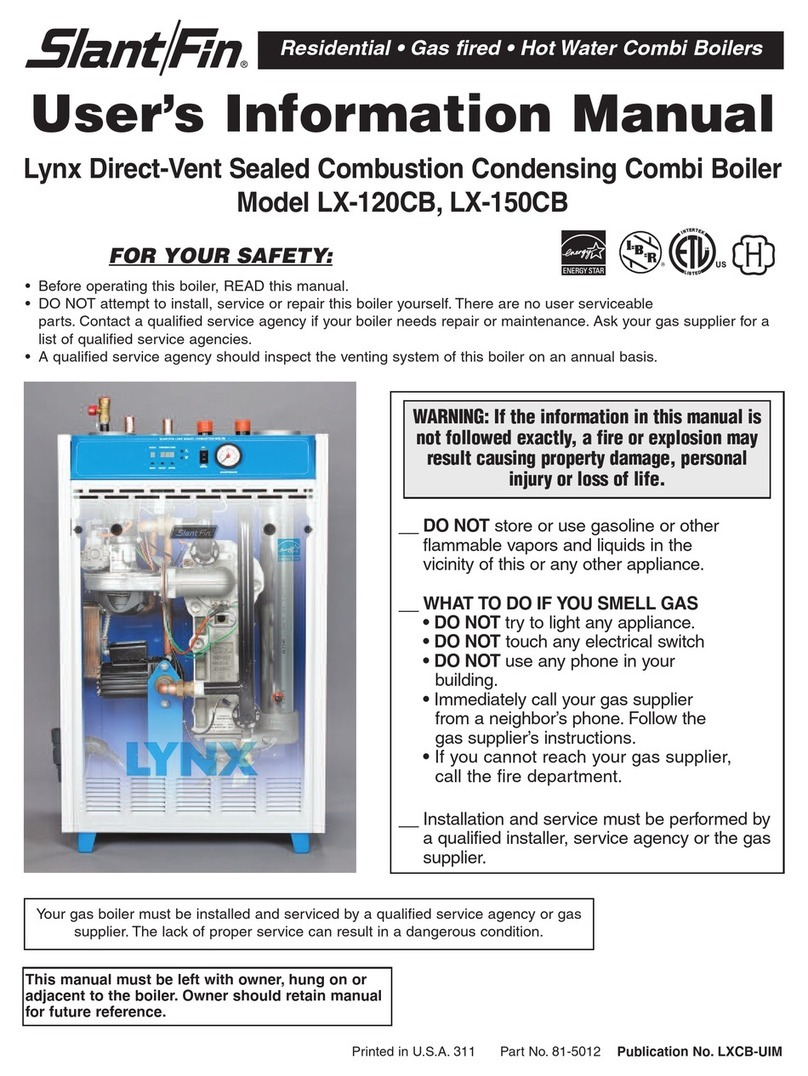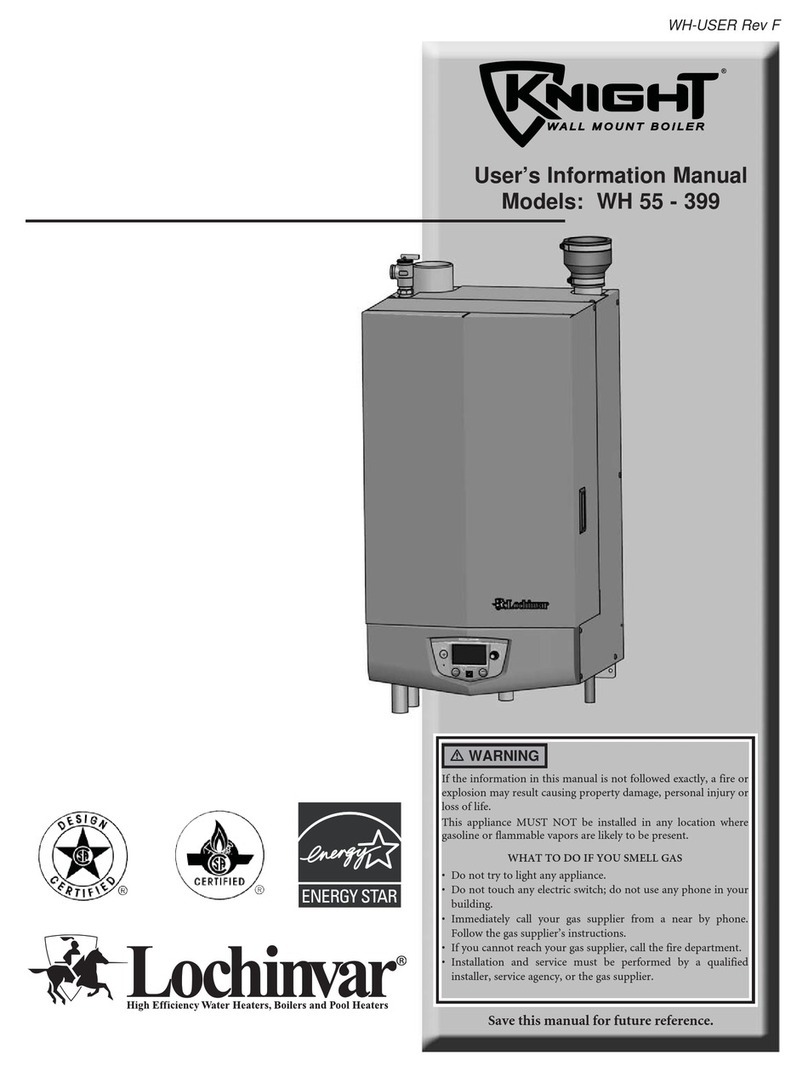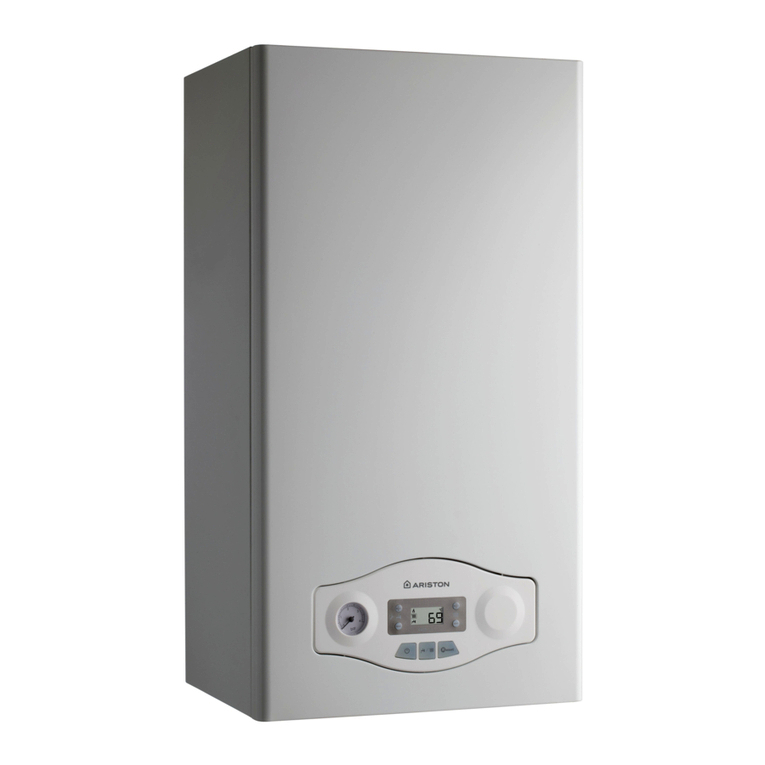Clean Energy CE-340 User manual

OWNER’S MANUAL
CE-340 Mul-Oil Boiler
With CE-4 Burner
Clean Energy Heating Systems, LLC
540 Maple Street, Honey Brook, PA 19344
www.CleanEnergyHeatingSystems.com
(888) 519-2347
WARNING: For your safety - DO NOT store gasoline or other flammable
vapors and liquids in the vicinity of this or any appliance.
CE70081
H
Heating Systems

7/3/13 Part # 70006
Underwriters Laboratories File # MH48829

TABLE OF CONTENTS
SAFETY CONSIDERATIONS AND GUIDELINES..............................................................4
REMOVING ITEMS FROM THE COMBUSTION CHAMBER............................................ 6
MOVING THE BOILER INTO POSITION .......................................................................... 7
BOILER ASSEMBLY........................................................................................................... 7
(1) Installing the combustion chamber sleeve.........................................................8
(2) Installing the burner........................................................................................... 9
(3) Installing the connector block and oil line.......................................................... 10
BOILER INSTALLATION.....................................................................................................11
(1) Selecting a location........................................................................................... 12
(2) Mounting the boiler in position...........................................................................13
(3) Connecting the electrical supply........................................................................ 13
(4) Installing the chimney components................................................................... 14
(5) Oil storage tank set up ......................................................................................17
(6) Installing the metering pump and oil lines......................................................... 17
(7) Connecting the compressed air line.................................................................. 22
(8) Installing the wall thermostat............................................................................. 22
(9) Disign and Installation of the Hydronics System............................................... 23
(10) Inspecting the Boiler Installation......................................................................25
BOILER CONTROLS AND SAFETY COMPONENTS........................................................26
PREPARING THE METERING PUMP FOR START UP.....................................................26
STARTING AND ADJUSTING THE BURNER.................................................................... 27
(1) Preparing the burner for start up....................................................................... 27
(2) Priming the oil pump..........................................................................................27
(3) Adjusting the Burner.......................................................................................... 27
RESETTING THE OIL PRIMARY CONTROL.....................................................................28
SETTING THE DRAFT........................................................................................................29
MAINTENANCE..................................................................................................................30
SEQUENCE OF OPERATION............................................................................................34
BOILER DIMENSIONS.......................................................................................................35
WIRE DIAGRAMS.............................................................................................................. 36
PARTS DIAGRAMS............................................................................................................ 38
CHIMNEY INSTALLATION DIAGRAMS............................................................................. 48
SERVICE RECORDS......................................................................................................... 50
APPENDIX A ......................................................................................................................51
(1) Alternate Controls............................................................................................... 51
(2) Domestic Hot Water Coil Installation.................................................................. 52
WARRANTY INFORMATION............................................................................................. 53

WARNING: Incorrect installation, adjustment, or misuse of this heating equipment
could result in death, severe personal injury, or substantial property damage.
To the Equipment Owner:
• Read and understand all instructions
provided in this manual
• Installation and service must be
completed by qualified personnel who
are familiar with oil-fired appliances.
• Save this manual for future reference.
To the Professional, Qualified Installer or
Service Agency:
• Read and carefully follow all instructions
provided in this manual before installing, starting,
or servicing this heating equipment.
• All installations must be made in accordance
with state and local codes having jurisdiction.
SAFETY CONSIDERATIONS AND GUIDELINES
NOTICE: Intended to clarify or bring special attention to previous information.
CAUTION: Indicates a hazardous situation, which can result in minor or moderate
personal injury if not avoided.
WARNING: Indicates a hazardous situation, which can result in death or serious
personal injury if not avoided.
DANGER: Indicates a hazardous situation, which will result in death or serious
personal injury if not avoided.
DANGER: DO NOT store or use gasoline or other flammable/explosive liquids/vapors
in or around the boiler.
DANGER: DO NOT operate the boiler if excess oil, oil vapors, or fumes have
accumulated in or around the boiler.
DANGER: Improper installation, operation, or maintenance of the boiler may create a
fire or explosion hazard.
WARNING: DO NOT mix unapproved substances to the used oil supply, such as:
• Anti-Freeze
• Carburetor Cleaner
• Paint Thinner
• Parts Washer and/or Solvents
• Gasoline
• Oil Additives
• Chlorinated solvents
• Any other inappropriate / hazardous material
Instruct your personnel NEVER to add unapproved substances to your used oil.
Burning any unapproved substance will immediately void the boiler warranty and may
cause damage and unsafe operating conditions.
WARNING: Unauthorized boiler modifications may cause damage and unsafe
operating conditions.
HAZARD DEFINITIONS:
SAFETY CONSIDERATIONS:
4

WARNING: The CE-4 Burner is only approved for use on heating equipment
manufactured by Clean Energy Heating Systems. The boiler is only approved for use
with the CE-4 burner manufactured by Clean Energy Heating Systems.
WARNING: The installation, operation, and maintenance of this equipment in the
United States must be done by qualified personnel according to instructions in the
Clean Energy Heating Systems Owner’s Manual and in accordance with all national,
state, and local codes or authorities having jurisdiction and the following standards:
ASME Section IV Boiler Code for Pressure Vessels
ASME CSD-1 Controls and Safety Devices for Automatically Fired Boilers
NFPA 30 Flammable and Combustible Liquids Code
NFPA 30A Automotive and Marine Service Station Code
NFPA 31 Installation of Oil Burning Equipment
NFPA 70 National Electrical Code
NFPA 88A Parking Structures
NFPA 88B Repair Garages
NFPA 211 Chimney’s, Fireplaces, Vents and Solid Fuel Burning Appliances
Likewise, the installation, operation, and maintenance of this equipment in Canada must
be done by qualified personnel according to instructions in the Clean Energy Heating
Systems Owner’s Manual and in accordance with all regulations and authorities having
jurisdiction and the following CSA Standards:
B139 Installatin Code for Oil Burning Equipment
B140.0 General Requirements for Oil Burning Equipment
B140.7.2 Oil Fired Steam and Hot Water Boilers for Commercial and Industrial Use
B214 Installation Code for Hydronic Heating Systems
C22.1 Canadian Electrical Code, Part 1
GUIDELINES FOR BOILER USE:
• This boiler is for industrial and/or commercial use only. This boiler is not intended
for residential use.
• Clean Energy Heating Systems boilers are listed with Underwriters Laboratories (UL)
in the U.S. and Canada to burn the following fuels:
• #2 fuel oil
• Used crankcase oil up to 50 SAE
• Used hydraulic oil
• Used automatic transmission fluid (U.S.)
• The EPA regulations for burning used oil are as follows:
• Your supply of used oil is generated on-site. You may also collect oil from
“do-it-yourself” oil changers.
• Do not mix hazardous wastes, such as chlorinated solvents, with your used oil.
• The exhaust gases of the heating equipment must be vented to the outside
with an appropriate stack system.
• The boiler is used to recycle used oil for “heat recovery”. The boiler is not
to be used in warm weather just to dispose of used oil.
• Only trained authorized personnel should service and maintain the boiler. Be sure
the boiler receives annual maintenance to ensure safe and efficient operation.
5
SAFETY CONSIDERATIONS AND GUIDELINES

GUIDELINES FOR USED OIL TANKS:
(1) The tank installation must comply with NFPA 30 and NFPA 31 fire codes.
(2) The tank should be installed on a slight slope with a drain on the low end to allow sludge
and water to be removed from the bottom of the tank.
(3) All oil lines must be constructed of copper, steel, or brass components. DO NOT use
rubber, plastic, or any other inappropriate material for oil lines.
(4) Be sure to follow all instructions for tank installation in the Owner’s Manual.
6
WARNING: To avoid serious injury or death, only store the following substances in
the oil supply tank:
(1) Used Crankcase Oil
(2) Used Automatic Transmission Fluid (ATF)
(3) Used Hydraulic Oil
(4) #2 Fuel Oil (Diesel Fuel)
DO NOT put flammable or corrosive substances such as gasoline, chlorinated solvents,
paint thinner, or any other unsafe substance in the oil supply tank.
WARNING: To avoid serious injury or death, do not weld or allow open flames within
35 feet of the used oil supply tank.
SAFETY CONSIDERATIONS AND GUIDELINES
(1) Remove the four nuts from the front door.
(2) Carefully swing the front door open.
(3) Remove the items packed inside the combustion chamber.
(4) Leave the door open to install the combusion chamber sleeve as instructed later in this
manual.
REMOVING ITEMS FROM THE COMBUSTIN CHAMBER
WARNING: Waste oil may contain gasoline. Take precaution when handling and
storing waste oil.
ADDITIONAL GUIDELINES FOR CANADIAN INSTALLATIONS:
NOTICE: This appliance has been evaluated to electrical and fuel-burning requirements only.
(1) The installation, including stack height requirements and distance from property lines, shall
be in accordance with the authorities having jurisdiction concerning environmental quality,
as well as fuel, fire, and electrical safety and Table 7 in CSA B140.0-03.
(2) The structure in which the boiler is housed shall be no less than 4.6 m (15 ft) high at the
point where the boiler is situated and have a minimum length and width of 6 m (20 ft) and
a minimum floor area of 37 m2(400 ft2).
(3) Every month, the fire side of the heat exchanger and flue piping must be cleaned.
(4) Every month, the oil-feed reservoir must be cleaned.
(5) Every year, the exhaust stack must be cleaned.
(6) Whenever any cleaning, including that of the flue piping and exhaust stack, is done, proper
protective clothing including gloves and a face mask or respirator must be worn.
(7) Keep the fuel valve nearest to the supply tank shut off when the burner is shut off for
extended periods.
CAUTION: Used oils contain heavy metallic compounds and foreign materials. When
burned, these compounds are emitted from or deposited within this heating appliance
and therefore care should be taken when using, cleaning and maintaining this equipment.

Figure 2: Typical Boiler Assembly
Follow the steps below for boiler
assembly (refer to Figure 2):
(1) Install the combustion
chamber sleeve
(2) Install the burner
(3) Install the connector block
and oil line
BOILER ASSEMBLY
7
Figure 1: Boiler Shown Without Shrouding To Reveal Lifting Points
(1) Refer to Figure 1.
(2) There are two angles 24” apart to allow for easy lifting.
(3) The boiler can be lifted from either side with a forklift or pallet truck.
(4) The boiler can also be lifted from either the front or back. The legs are spaced 27” apart
which allows the use of a standard pallet truck.
WARNING: Because of the weight and size, take extreme care when moving the
boiler.
(x2) ANGLE WELDED
TO BOILER FRAME
CE70095
ANGLE
WELDED
TO BOILER
FRAME
24.0
27.0
(BETWEEN LEGS)
BOTTOM
VIEW
NOTICE: To reduce the chance of damage, move the boiler into position before installing the
burner.
MOVING THE BOILER INTO POSITION
CE70082
2
3
1

8
Installing the Combustion Chamber Sleeve:
NOTICE: Improper combustion may occur if the boiler is used with a damaged or missing
combustion sleeve. Inspect the combustion sleeve regularly for proper positioning and wear.
(1) Refer to Figures 3 and 4 to view the proper position of the combustion chamber sleeve.
(2) Open the front door of the boiler by loosening the four bolts and swinging the door open.
(3) Place the 3”x3”x20” support blocks on the bottom of the combustion chamber as shown.
(4) Place the combustion chamber sleeve on top of the support blocks and flush with the front
door.
(5) Close the front door and secure the four bolts.
BOILER ASSEMBLY
Figure 3: Proper Position of the Combustion Chamber Sleeve
COMBUSTION SLEEVE
FLUSH AGAINST DOOR
CE70083

9
Installing the Burner:
NOTICE: The nozzle, electrode, and retention head may need adjustment after shipping and
installation. The nozzle should remain centered in the retention head. Refer to Figure 5 for
proper dimensions.
(1) Remove the two serrated flange nuts from the front door.
(2) Slide the blast tube of the burner through the throat of the front door.
(3) Fasten the burner to the front door by tightening the two serrated flange nuts.
Figure 5: Nozzle and Electrode Settings
BOILER ASSEMBLY
3/16" GAP
BETWEEN
ELECTRODES
AND NOZZLE
CE70018
1/8" GAP BETWEEN
ELECTRODES
ELECTRODE 1/8"
PAST NOZZLE
Figure 4: Combustion Chamber Sleeve Location
APPROX.
10"
SUPPORT
BLOCK (X2)
CE70084

10
Installing the Connector Block and Oil Line:
(1) Refer to Figure 7 to position the connector block.
(2) Fasten the connector block to the side of the boiler
with the bolts provided.
(3) Install the supplied 3/8” copper tubing from the swivel
fitting in the connector block to the burner.
NOTICE: The connector block with the swivel fitting
must be used to allow the front door to swing open
properly. If the connector block is not used the oil line will
need to be disconnected before the door is opened.
Figure 7: Installing the Connector Block and Oil Line
Figure 6: Installing the Burner Cord
(4) Refer to Figure 6
(5) Line up the key in the receptacle with the slot in the
cord.
(6) Tighten the electrical cord when in position.
NOTICE: Make sure the plug and receptacle are
properly aligned. The ground prong in the receptacle
is longer than the other prongs and must be lined up
properly.
BOILER ASSEMBLY
WARNING: To prevent the risk of electrical
shock, shut OFF main power to the boiler before
connecting or disconnecting the burner power
cord.
CE70013
CE70085
Oil Line
Connector Block

11
Figure 8: Typical Boiler Installation
Refer to Figure 8 for a typical boiler installation illustration.
Installation of your boiler will include the following steps:
(1) Selecting a location (6) Installing the metering pump and oil lines
(2) Mounting the boiler in position (7) Connecting the compressed air line
(3) Connecting the electrical supply (8) Installing the wall thermostat
(4) Installing the chimney components (9) Design and Installation of hydronics system
(5) Positioning the oil storage tank (10) Inspecting the boiler installation
BOILER INSTALLATION
8 FT. MAXIMUM LIFT
DEDICATED ELECTRIC SERVICE
OIL PUMP ELECTRICAL CIRCUIT
COMPRESSED
SUCTION
OIL LINE
10 FT.
3 FT.
8" MIN
RELIEF
RETURN
CE70086
PRESSURE
OIL LINE
OIL STORAGE
TANK
AIR LINE
(MIN.)
OIL PRESSURE LINE
5 FT.
MINIMUM

12
Select a location:
There are several considerations when selecting a location for the boiler:
(1) Do not obstruct shop personnel or equipment
(2) Find a location where the boiler can easily be moved into place.
(3) The installation must meet the clearance to combustible material requirements (Figure 9)
(4) The location must be safely accessible for maintenance and service
(5) The installation must comply with all local codes and regulations
(6) Keep the stack / chimney system simple. A complicated stack with multiple elbows and
long horizontal runs will reduce the natural draft of the unit which can damage critical
burner components.
Figure 9: Clearances to Combustible Materials
Minimum Distances from Combustible Materials
WARNING: Carefully follow all installation instructions for safe and efficient operation.
BOILER INSTALLATION
Front (Burner) 18” (48” for service clearance)
Back 18” (36” for service clearance)
Side 6”
Top 18”
Chimney Connection 18”
CE-340 BOILER
CLEARANCE)
(FOR SERVICE
FRONT 48"
BOTTOM 6"
CE70078
SIDE 6"
CLEARANCE)
(FOR SERVICE
BACK 36"
STACK 18"
TOP 18"

13
Mounting the Boiler in position:
(1) Refer to Figure 8 for a typical installation.
(2) Set the boiler in position.
(3) Raise the four legs up if desired.
(4) Fasten the four legs to the floor through the holes in the pads on the bottom of each leg.
(5) Use a level to ensure the boiler is level front-to-back and side-to-side.
WARNING: The floor or pad for boiler installation must support the weight of the boiler
when it is full of water. A level concrete floor or pad is recommended.
BOILER INSTALLATION
Connecting the electrical supply to the Boiler:
Electrical Requirements:
120 V / 60 Hz
Single Phase
20 Amp dedicated circuit
WARNING: Shut off main power to the boiler before making any electrical
connections. ONLY a qualified electrician should run wire and make connections to the
boiler. All wires must be the proper gauge and run in approved electrical conduit. All
wiring must meet the requirements of the National Electrical Code.
(1) Install a dedicated electrical circuit to the junction box above the burner.
(2) Connect the wires according to the label found on the inside of the junction box cover or
in the wire diagrams section of this manual. Use stranded copper wire to ensure a secure
connection.

14
BOILER INSTALLATION
Installing the chimney components:
WARNING: Double wall “Class A” insulated stack must be used through any building
penetration and for any exterior stack. Unapproved stack material and/or installation
can create a fire hazard. Contact Clean Energy Heating Systems, LLC to purchase
approved stack material for your installation.
CAUTION: Using single wall stack on the exterior of your building will cause the stack
gases to cool rapidly and adversely affect the natural draft of the boiler. This will create
a back draft and may damage critical burner components.
(1) Refer to Figure 10 for a typical through-the-roof chimney illustration and Figure 11 for a
typical through-the-wall chimney illustration.
(2) Observe the following requirements when installing the chimney:
• The CE-340 boiler requires 8” I.D. stack components.
• Have a minimum of 10 feet vertical chimney to ensure -.02” w.c. draft over fire.
• Keep horizontal runs short. Slope any horizontal sections at least 1/4” per foot.
• Keep the stack installation simple. Multiple turns and horizontal runs will reduce the
natural draft of the boiler which may damage critical burner components.
(3) Single wall stack may be used inside the building. Observe proper clearances from
combustibles. Do not put single wall stack in areas that may create a burn hazard to
personnel.
(4) Install a barometric damper, as shown in Figures 10 and 11, so that proper draft can be
maintained. Follow the instructions provided with the damper for proper installation.
(5) Use double wall “Class A” insulated stack when making a penetration through the roof or
side wall of your building. Install proper flashing around the exterior penetration of the
stack to make a water tight seal. Clean Energy Heating Systems, LLC recommends
“Dektite” flexible pipe flashing, or equivalent, for through the roof installations.
(6) Install a “Class A” non-restrictive stack cap only.
CAUTION: IF YOUR BUILDING UTILIZES AN EXHAUST FAN, ensure that there
is adequate make-up air available. Lack of make-up air will create a vacuum in your
building which will result in a back draft at the boiler. A back draft will damage critical
burner components.

15
BOILER INSTALLATION
Figure 10: Typical Through-the-Roof Chimney Illustration
10 FT.
3 FT.
(MIN.)
"CLASS A" STACK
COMPONENTS
MINIMUM 10 FT. VERTICAL
STACK HEIGHT TO MAINTAIN
PROPER DRAFT
SINGLE WALL STACK
COMPONENTS
BAROMETRIC
DAMPER
"CLASS A" STACK CAP
NON-RESTRICTIVE TYPE
SET DRAFT
OVER FIRE
AT -0.02
IN. W.C.
CE70080

16
Figure 11: Typical Through-the-Wall Chimney Illustration
BOILER INSTALLATION
10 FT.
CE70079
3 FT.
(MIN.)
"CLASS A" STACK CAP
NON-RESTRICTIVE TYPE
MINIMUM 10 FT. VERTICAL
STACK HEIGHT TO MAINTAIN
PROPER DRAFT
"CLASS A" STACK COMPONENTS
INSTALL AN ADEQUATE
WALL SUPPORT SYSTEM
TO SAFELY BEAR THE
WEIGHT OF THE
"CLASS A" STACK
SET DRAFT
OVER FIRE
AT -0.02
IN. W.C.
BAROMETRIC
DAMPER

17
Oil storage tank setup:
Figure 12: Typical Oil Storage Tank Installation
(1) Refer to Figure 12 for a typical oil storage tank setup.
(2) The tank must be installed according to all NFPA requirements and State and Local codes.
(3) An inside tank is recommended.
(4) Locate the tank in a position that will allow the oil pump to be mounted as close as possible
(5) Only use a tank with a drain on the bottom. Over time, dirt and sludge will naturally
accumulate on the bottom of the tank and there must be a way of removing this unwanted
material.
(6) Some state and local codes require the tank to be vented to the outside.
(7) Educate all personnel what substances are allowed to be added to the used oil supply and
apply the provided tank warning label near the fill location.
Installing the metering pump system and oil lines:
Metering Pump Installation Guidelines:
(1) Use non-hardening thread sealer for all threaded pipe fittings. DO NOT use teflon tape.
(2) The pump must be installed with the shaft in the horizontal position and the oil outlet
pointing up.
NOTICE: The gauge arrow on the front of the pump head must be pointing up.
CAUTION: The metering pump must be mounted above the oil tank. The pump is
not designed to take head pressure. If the pump is below the level of oil in the tank the
pump seals may begin to leak.
BOILER INSTALLATION
8 FT. MAXIMUM LIFT
SUCTION
OIL LINE
8" MIN
RELIEF
RETURN
CE70024
PRESSURE
OIL LINE
PRESSURE OIL LINE TO
THE HEATING EQUIPMENT
EMERGENCY
VENT
DRAIN PAN
WITH SHUT OFF
VALVE
CHECK VALVE
CLEAN OUT
VALVE WITH
PLUG
SUCTION OIL LINE IS ONE CONTINUOUS
PIECE OF COPPER TUBING INSTALLED
THROUGH THE SLIP FITTING
VENT
CAP

Figure 13: Typical Metering Pump Installation (Standard Mounting on a Wall)
(3) The metering pump system is a fixed displacement pump. The pump shaft is driven by
a gearmotor at a specific rpm, for each specific model. This delivers a constant flow
(gph) of fuel. Change in oil viscosity and temperature have very little effect on fuel flow.
Therefore no oil pressure adjustment is needed for the metering pump system.
(4) The metering pump must be mounted as close to the tank as possible. The suction oil
line (length of oil line from the bottom of the tank up to the pump) must not exceed 8
vertical feet. Every 3 horizontal feet of suction line reduces the maximum allowable
vertical lift by 1 foot.
(5) The suction oil line must be a minimum of 8” from the bottom of the tank to reduce the
likelihood of sludge and/or water being delivered to the boiler.
(6) The metering pump system is not weatherproof. Mount the pump indoors only.
Mounting the metering pump assembly:
NOTICE: The metering pump system comes assembled for standard mounting on a wall.
STANDARD MOUNTING:
(1) Refer to Figure 13 for a typical metering pump installation (standard mounting on a wall).
(2) Use appropriate hardware to mount the metering pump system to the wall.
(3) Keep the pump assembly as close to the tank as possible.
ALTERNATE MOUNTING:
(1) Refer to Figure 14 for an illustration of the alternate horizontal mounting.
(2) Loosen the pump head and rotate it 90o. The pump assembly may now be mounted in the
horizontal position as on a shelf.
18
BOILER INSTALLATION
PRESSURE OIL LINE TO
THE HEATING EQUIPMENT
PRESSURE RELIEF RETURN
OIL LINE TO THE TANK
(1/4" COPPER TUBING)
SUCTION OIL
LINE TO TANK
(1/2" COPPER TUBING)
BALL VALVE
USED FOR
VACCUUM TEST
FILL BALL
VALVE
CANISTER FILTER
VACUUM GAUGE
BLEEDER VALVE
CE70025
A
A

Figure 14: Alternate Horizontal Metering Pump Mounting
19
Installing the suction oil line:
(1) Refer to Figure 15.
(2) Measure the height of the tank. Reduce this measurement by 8” and mark the 1/2” copper
suction line tubing at this length.
(3) Install the 1/2” MNPT slip-through fitting into the side of the 2” duplex fitting marked “S”.
(4) Slide the 1/2” copper suction line tubing through the slip fitting in the 2” duplex fitting up
until the mark that was made indicating 8” less than the height of the tank.
(5) Install the 1/2” flare fitting into the foot valve (arrow on foot valve pointing toward the flare).
(6) Flare the 1/2” copper suction line tubing and install it on the foot valve.
(7) Insert the suction tubing into the tank and tighten the 2” duplex fitting.
(8) Carefully bend the 1/2” copper suction line tubing up to the filter and cut it to length.
(9) Flare the 1/2” copper suction line tubing and install it on the filter.
Installing the pressure relief oil line back to the tank:
(1) Refer to Figure 15 and 16.
(2) Install the 1/2” MNPTx1/4” compression fitting into the side of the 2” duplex fitting marked“R”.
(3) Run a piece of 1/4” copper tubing from the pump relief valve back to the tank.
BOILER INSTALLATION
PRESSURE OIL LINE TO
THE HEATING EQUIPMENT
PRESSURE RELIEF RETURN
OIL LINE TO THE TANK
(1/4" COPPER TUBING)
FILL BALL
VALVE
CANISTER FILTER
VACUUM GAUGE
BLEEDER VALVE
CE70014
A
SUCTION OIL
LINE TO TANK
(1/2" COPPER TUBING)
BALL VALVE
USED FOR
VACCUUM TEST
A

20
Figure 16: Metering Pump Pressure Relief Valve
Figure 15: Installing the Suction Oil Line
BOILER INSTALLATION
CE70026
1/2" FOOT VALVE
SUCTION OIL LINE IS ONE CONTINUOUS
PIECE OF COPPER TUBING INSTALLED
THROUGH THE SLIP FITTING
A
DETAIL A
1/2" MNPT
SLIP-THROUGH
FITTING
1/2" FLARE FITTING
SUCTION OIL LINE
(1/2" COPPER TUBING)
PRESSURE RELIEF RETURN
OIL LINE (1/4" COPPER TUBING)
2" DUPLEX FITTING
1/2" MNPT X 1/4"
COMPRESSION
CE70027
PRESSURE
RELIEF
VALVE
PRESSURE RELIEF
RETURN OIL LINE
TO THE TANK
(1/4" COPPER TUBING)
LOW FLOW
CHECK VALVE
Table of contents
Popular Boiler manuals by other brands
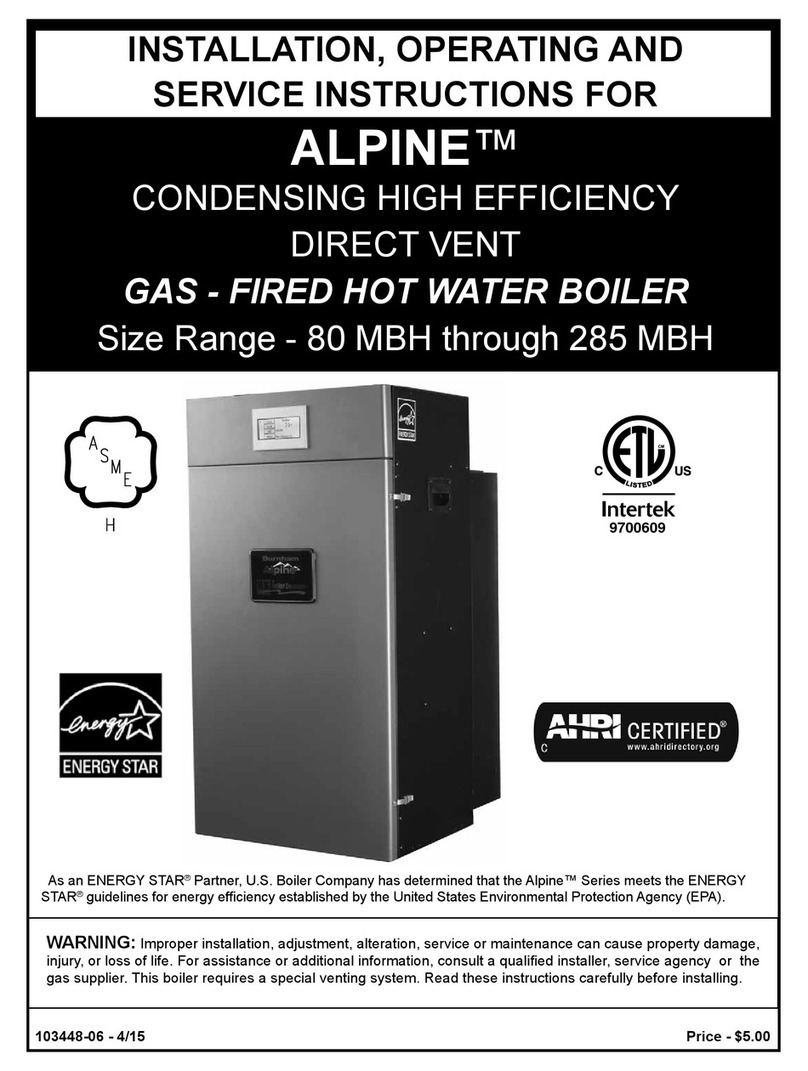
Alpine
Alpine ALP080B Installation, operating and service instructions

Viessmann
Viessmann VITOCROSSAL 300 Service instructions for contractors

Ideal Boilers
Ideal Boilers icos HE12 user guide
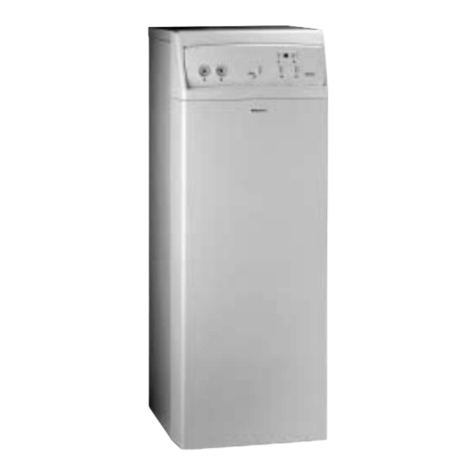
Hercules
Hercules Condensing 20 manual
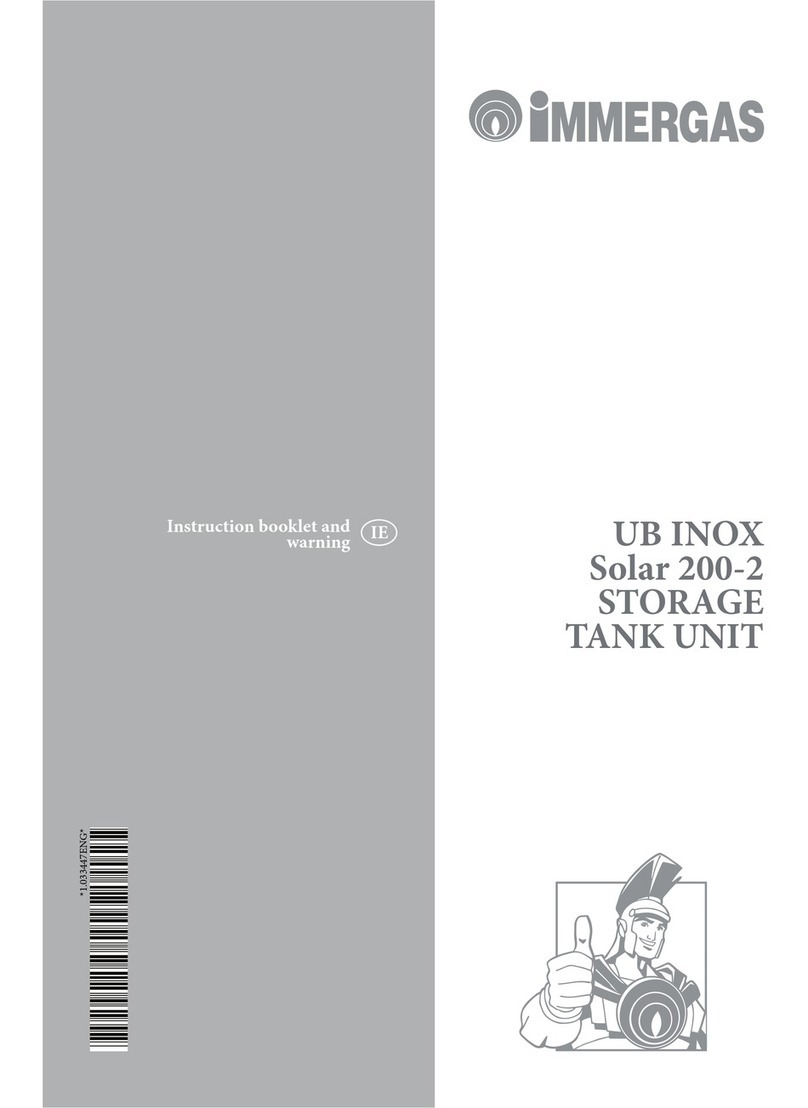
Immergas
Immergas UB INOX SOLAR 200-2 Instruction booklet and warning

Fröling
Fröling T4e 20 installation instructions

IDEAL
IDEAL ES24 user guide
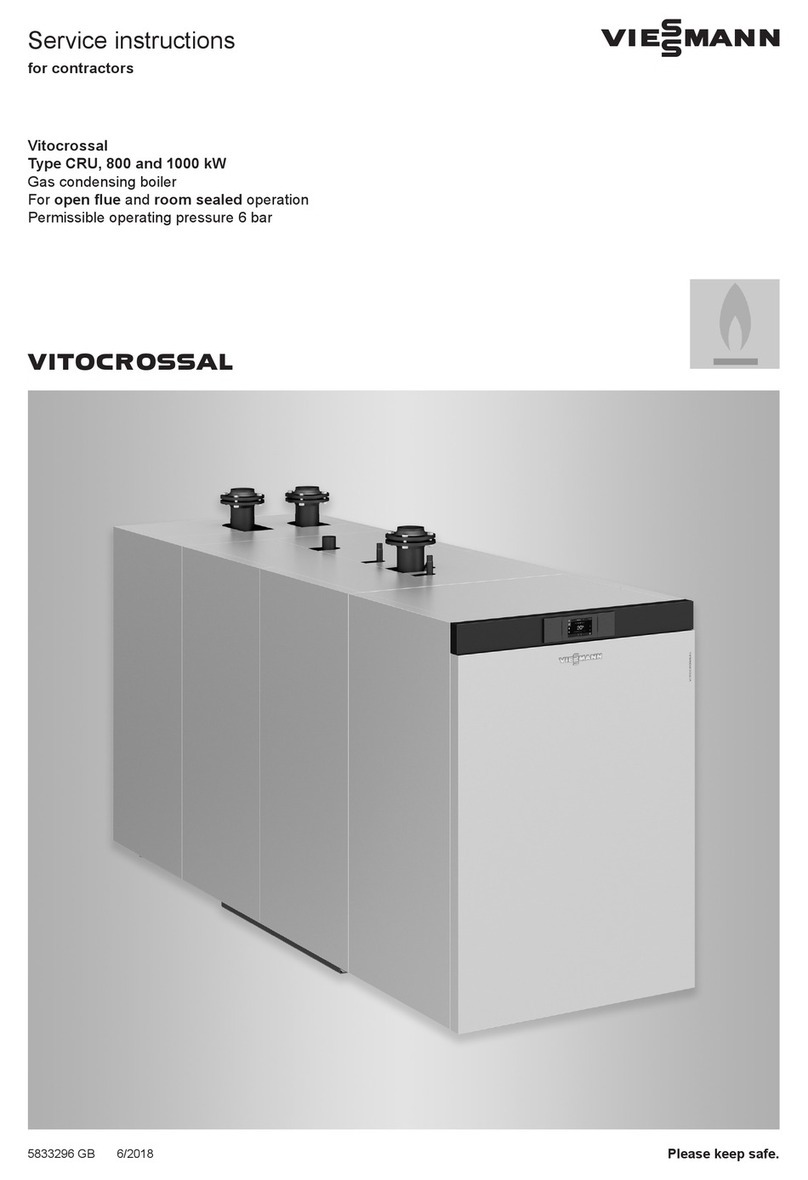
Viessmann
Viessmann Vitocrossal CRU 800 Service instructions for contractors

Worcester
Worcester GREENSTAR 29CDi Classic ErP Installation, commissioning and servicing instructions
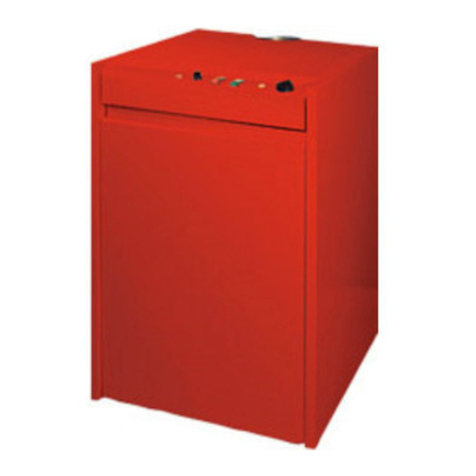
Chappee
Chappee EDENA CLASSIC E 35 Installation and servicing instructions

Buderus
Buderus Logano G334 X instructions
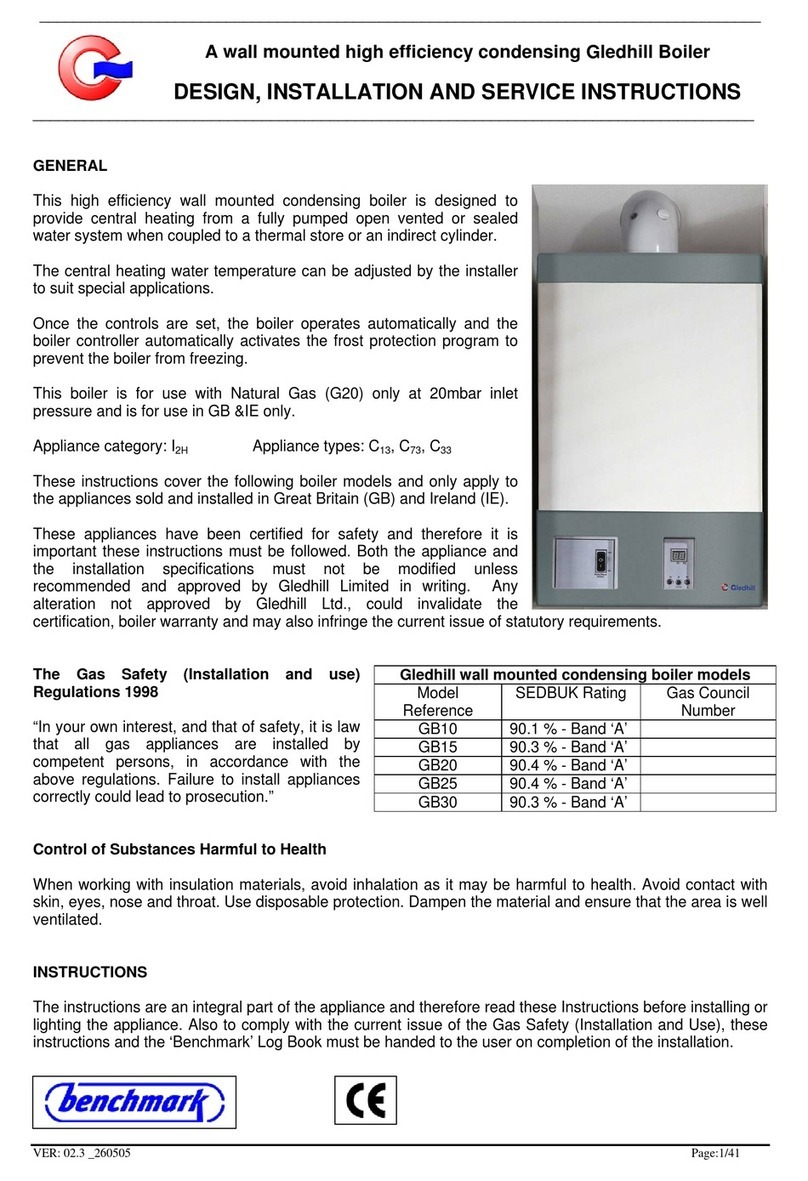
Benchmark
Benchmark GB10 Design, installation & servicing instructions
